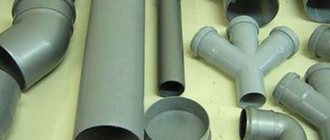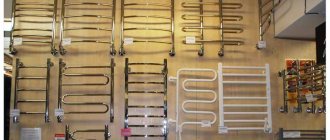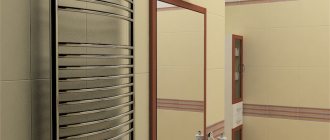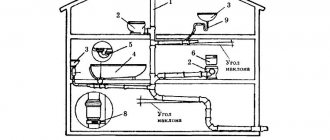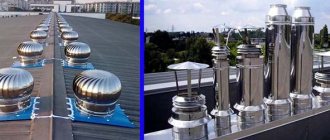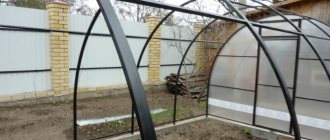Quite often, cosmetic renovations in a private apartment develop into a large-scale reconstruction. This is natural - how can you leave an old and unaesthetic towel dryer against the background of the new tiles laid in the bathroom? It would seem that the essence of the issue is clear and the only thing left is to purchase a new unit and install it or hire a specialist.
However, not all so simple. You can figure out the choice of the desired product model yourself. But issues with replacing a heated towel rail will have to be resolved through the housing office or a commercial company specializing in such work. Let's look at some of the subtleties of this topic.
We connect a heated towel rail made of polypropylene
Before buying a clothes dryer, you must decide on its immediate purpose. And only then will you decide on its shape: a coil, a ladder or another decorative look. A heated towel rail can perform extremely practical functions.
Polypropylene heated towel rail.
Then think about the material of manufacture, its color and the immediate installation location. It is best to prepare the location for the device in advance during repairs. Based on the intended space, choose a heated towel rail of the appropriate size.
Experts note that devices made of polypropylene pipes and stainless steel are the most trusted. Products made from such materials are distinguished by great practicality and a variety of designs.
Polypropylene heated towel rails are available in a wide range of sizes and shapes. This material is easy to paint, thereby matching its color to the design of the bathroom.
Among the variety of forms, the most popular among consumers are ladders, loops or coils. It is these forms that stand out for their attractiveness and practicality. They fit perfectly into the interior and are beneficial for daily drying of small laundry.
Coil made of polypropylene. This model is universal - suitable for both apartments and private houses. To install a heated towel rail in the form of a coil in an apartment, experts recommend purchasing a dryer with a diameter of at least 20 mm. This is the diameter of risers in apartment buildings.
To connect the dryer in a private home, purchase a device with a diameter of 25 mm. You may need a smaller diameter, so as not to make a mistake, find out in advance the dimensions of the pipes in the house.
Ladder made of polypropylene. Very often, consumers purchase a heated towel rail in the form of a ladder to heat the entire bathroom, choosing products with a large number of slats. Manufacturers also offer us special devices with increased power designed for heating the room.
For installation in an apartment, experts recommend choosing a diagonal connection, and for installation in a house - a bottom connection.
How does the shape of the device affect installation?
The efficiency of water circulation and the absence of stagnant or airy areas depend on the shape of the heated towel rail.
The most effective are U- or M-shaped structures that do not have complex intersections or bends.
Water enters them from one end of a curved pipe and leaves the other without changing its speed or stopping.
However, modern substation designs, made in the form of ladders or in the form of complex spatial lattices, are more convenient for operation. They provide more options for drying towels, but require proper connection.
What is needed to install a water heated towel rail?
Many clothes drying devices become unusable over time, and repairing does not make sense. They become less and less warm, and then stop heating altogether. The best solution is to connect a new heated towel rail.
To replace the old device and install a new one, you will need the following tools:
- new heated towel rail;
- polypropylene pipes;
- mount or special brackets for mounting the device;
- machine for welding polypropylene pipes;
- special knife for cutting pipes;
- connecting fittings and couplings, respectively, made of polypropylene;
- several ball valves: two or three.
If possible, prepare everything you need in advance to speed up the connection as quickly as possible and minimize any hiccups.
Connecting a heated towel rail made of polypropylene
Installing a drying device is a painstaking job that requires your attention and diligence, but the work is not so difficult, you can handle it yourself.
Step No. 1: dismantling the old heated towel rail.
Before any work in the bathroom, it is imperative to turn off the water and drain the remaining water into any container.
Remove everything unnecessary from the room, place a bucket or any other vessel under the heated towel rail (water may remain in the pipes). Now you can safely put away your old device.
Step No. 2: installation of jumper and ball valves.
A jumper or bypass is your help, the installation of which is optional, but desirable. It can save you in case of an unexpected leak or other problem. To avoid calling emergency services in the middle of the night, the jumper will be your insurance.
The jumper is a special polypropylene pipe that is installed in the ball valves at the ends of the heated towel rail. This polypropylene pipe promotes constant circulation of water in the riser, even when the device is turned off.
To remove air from the heated towel rail, it is necessary to install additional ball valves in the jumper. This trick will help ensure smooth circulation of hot water in the heated towel rail.
Step No. 3: preparation of polypropylene pipes - welding.
Experienced experts note that polypropylene pipes are the most reliable option for a heated towel rail.
- the material does not corrode;
- affordable price;
- are light in weight;
- durable;
- resistant to elevated temperatures due to special fiber reinforcement;
- easily connects to metal pipes due to various fasteners and fittings;
- ease and simplicity of installation.
To secure the heated towel rail pipes, or rather weld them, you will need a special welding machine. Don't be afraid, it is quite simple to operate and understanding its controls will not be difficult. In addition, these devices can be easily rented.
Apparatus for welding polypropylene pipes.
Step No. 4: connecting a new heated towel rail.
The main task at this stage: install a device for drying clothes and connect it to polypropylene pipes using a welding machine.
When installing a heated towel rail, be careful to maintain the slope of the supply pipe. Water must pass through the entire mechanism from top to bottom; accordingly, the riser must be connected to the upper socket of the drying device.
When fixing the heated towel rail to the bathroom wall, you must maintain certain distances:
- if the diameter of the pipes is 23 mm or less, the distance between them and the wall should be no more than 35 mm;
- if the pipe diameter is more than 23 mm or more, the distance between the wall and the heated towel rail should be 50 mm.
Experts recommend not fixing the device too rigidly; it is better to use the brackets that come with the mechanism. This way you will protect the walls from heavy loads and various deformations from high temperatures.
What is the procedure for replacing an old heated towel rail through the housing office?
How to choose a contractor?
If you decide to entrust all the work to professionals, then you need to seriously think about their choice - you should not trust the first one you come across. Here, naturally, the cost of services and the time of their provision play a big role.
However, we must not forget about the reputation of the company. Moreover, they must provide documentation that gives them the legal right to carry out such work. The main documents are the SRO certificate of approval and the contract. It is the SRO certificate that is important, since the license has been canceled since 01/01/2010.
Of course, replacing a heated towel rail and the price for performing the work in this case will be higher than that of ordinary performers. At the same time you receive the following benefits :
- qualified order execution;
- high-quality components;
- contractor's liability;
- warranty obligations.
All this can be lost if the replacement is made by a “left” plumber. It’s good when negative consequences can be avoided, for example, a simple leak, after which you will have to redo not only all the work, but also carry out repairs for flooded neighbors. Therefore, it is better to immediately contact a company with relevant experience and documentation.
Let's go to the housing office
So, the choice of the master has been made, but this is only the beginning of the process. Now there is a not entirely simple procedure for disconnecting the riser to which the towel drying device is connected. Some companies, when replacing an old heated towel rail through the housing office , take on this hassle, although they require a certain fee for this.
However, not everyone is able to pay for this service, so we will consider the process in more detail. The procedure is as follows:
- contact the housing department with an application containing a request for permission to change the old towel drying device;
- upon receipt of permission, contact the dispatcher and agree on the time for the work to be completed;
- install the unit and check its operation;
- invite a representative of the housing department to check the compliance of the work performed with the permit.
Housing department employees do not have the right to refuse to disconnect if the contractor’s company has all the permits. The reasons for refusals are always related to attempts to impose their services, and at inflated rates. In case of refusal, the reason must be indicated, and if the illegality of the actions of the office manager is discovered, a lawsuit should be filed.
Why should you choose polypropylene material?
Domestic plumbers and craftsmen trust German materials most of all, and no wonder.
German-made polypropylene pipes differ:
- small thermal expansion;
- low pressure loss;
- pipes do not require stripping during welding;
- affordable cost of pipes;
- ease of installation;
- high service life.
As many years of experiments have shown, polypropylene pipes can function for up to 50 years at high temperatures reaching +700.
For the circulation of hot water, experts recommend reinforced pipes. Such polypropylene pipes are called “stabi pipes”. In all their technical characteristics, such pipes are close to aluminum products.
This unique material – polypropylene, cools quickly after welding and easily returns to working condition, so you won’t have to wait long.
When choosing the best option for a heated towel rail, carefully consider all possible options. Study reviews and quality of devices. And only then will you see that it is polypropylene that makes the drying mechanism work longer than any other device and with better quality than any other device.
Using Bypass
In order for the system to function more efficiently, it provides for the installation of a bypass. It is a spare channel to which you can connect any equipment involved in heating. Its task is to ensure the functioning of the system when emergency situations occur in the connected components.
Usually, novice craftsmen do not think about the fact that leaks may occur. They fix the coils to the main pipes without installing shut-off valves. This approach during operation can cause a violation of the tightness of the connections and flooding of the room. This can have negative consequences if the room is located in a high-rise building with central heating.
When an emergency occurs, it may take a long time for the water supply to stop. Blocking and restoration work can leave part of the house without heat for an extended period of time. The bypass design is quite effective and simple, it allows you to gain confidence in the situation and not worry about the health of the equipment.
To carry out the work, you will need to create a kind of riser for the heated towel rail by installing tees at the ends of the pipes. Two directional outlets should be connected to a pipe. Side outlets are necessary for installing shut-off elements; pipes will be connected to them, which go to the heated towel rail.
When a structure is assembled from flexible ready-made connections, during its installation one should not forget about the use of sealing materials. When installing a plastic pipeline, you need to use a soldering iron. The master will need the help of one more person. When rigid connections are used for connection, you need to ensure compliance with the horizontal and vertical levels. Otherwise, the installed coil will not be able to be fixed evenly. Its incorrect position can ruin the entire impression of the repair.
Do-it-yourself installation and connection of a heated towel rail in the bathroom
Typically, installing a heated towel rail in a bathroom does not cause any particular difficulties - the tubular heater is hung on the wall using standard fasteners (included in the kit). Another issue is connecting a plumbing fixture to the utility networks of a private house or apartment. The choice of connection diagram depends on the type and location of the heater indoors. How to install a heated towel rail and connect it yourself, read in our guide.
Features of choice
If you don’t know which heated towel rail is best to choose, you should pay attention to the technical characteristics of the models, which must correspond to the pressure level during pressure testing and operation of the system. If we take into account the requirements of GOSTs and building codes that regulate the installation of water supply and heating systems, water-folding sanitary fittings should be used at a pressure of up to 6 atmospheres.
Theoretically, the pressure should not exceed 4 atmospheres, but in practice this value can vary from 2.5 to 7.5 atmospheres. The final value will depend on the location of the building, the number of floors and the condition of utilities.
Before purchasing a water coil, you should find out what pressure is maintained in the house, taking into account the possibility of water hammer. For a country house where the heating and water supply systems are autonomous, the pressure usually does not exceed 3 atmospheres, so choosing a device will not be so difficult.
Types of towel dryers
So, all wall-mounted bathroom heaters are divided into 3 types:
- Electric, operating from a 220 volt network. There are 2 types - with a heating cable inside or a liquid coolant and a heating element. Both options connect the same way.
- Water heated towel rails are connected to the hot water supply or heating system.
- In combined double-circuit devices, heat transfer is organized from 2 sources - electricity and the hot water supply network.
Note. The design of combined dryers is quite simple. The heater consists of 2 separate circuits - electric and water, which can operate simultaneously or alternately. Accordingly, the price of universal heated towel rails is 1.5–2 times higher.
The principle of operation of electrical appliances is as follows: the heating element or cable heats up to a given temperature, then the thermostat turns off the power. After the tubular body has cooled by 3–5 °C, heating automatically resumes. In heating element dryers filled with non-freezing liquid, air is discharged through the Mayevsky valve.
It’s easier with water dryers - they warm up to the temperature of the coolant flowing inside. The body is made of stainless or black painted steel, less often - of copper. Shape – in the form of a ladder, a coil, E-shaped, M-shaped. Since we are considering purely the installation of a heated towel rail, the shape and material do not play a big role, the only thing that matters is the connection method - side or bottom.
Preparation
If you need to move the device away from the riser, then before removing the heated towel rail, you will need to obtain written permission from the management company. The thing is that the further the device is located from the general water supply flow, the worse it will function, reducing the water pressure throughout the house.
It is prohibited to carry out such work independently without obtaining permission. It is most convenient to replace it in the summer, when the hot water supply is turned off. An excellent period will also be the time when preventive work is carried out.
